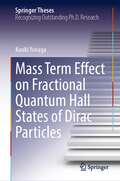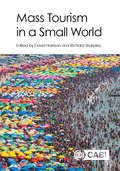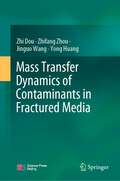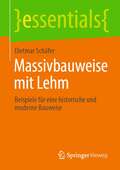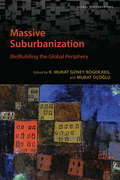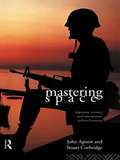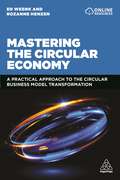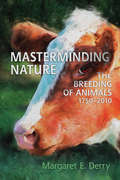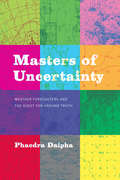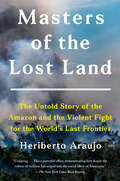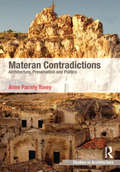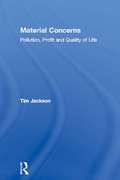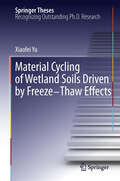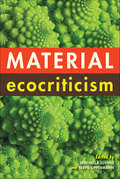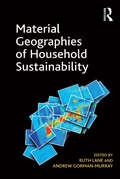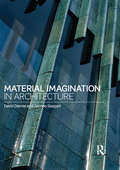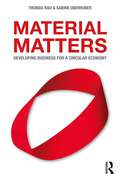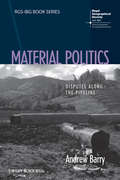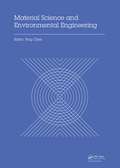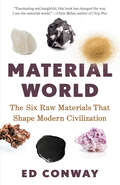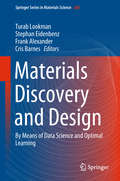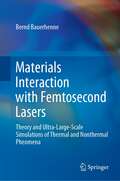- Table View
- List View
Mass Customisation and Personalisation in Architecture and Construction
by Frank T. Piller Poorang A.E. PiroozfarChallenged by the recent economic crisis, the building and construction industry is currently seeking new orientation and strategies. Here mass customisation is uncovered as a key strategy in helping to meet this challenge. The term mass customisation denotes an offering that meets the demands of each individual customer, whilst still being produced with mass production efficiency. Today mass customisation is emerging from a pilot stage into a scalable and sustainable strategy... The first dedicated publication of its kind, this book provides a forum for the concept within an applied and highly innovative context. The book includes contributions from some of the most prominent thinkers and practitioners in the field from across the world, including Kasper S. Vibaek, Steve Kendall, Martin Bechthold, Mitchell M. Tseng, and Masa Noguchi. Bringing together this panel of experts who have carried out research both in academia and practice, this book provides an overview of state-of-the-art practice related to the concept of customisation and personalisation within the built environment.
Mass Dimension One Fermions (Cambridge Monographs on Mathematical Physics)
by Dharam AhluwaliaIn 2005, Dharam Ahluwalia and Daniel Grumiller reported an unexpected theoretical discovery of mass dimension one fermions. These are an entirely new class of spin one half particles, and because of their mass dimensionality mismatch with the standard model fermions they are a first-principle dark matter candidate. Written by one of the physicists involved in the discovery, this is the first book to outline the discovery of mass dimension one fermions. Using a foundation of Lorentz algebra it provides a detailed construction of the eigenspinors of the charge conjugation operator (Elko) and their properties. The theory of dual spaces is then covered, before mass dimension one fermions are discussed in detail. With mass dimension one fermions having applications to cosmology and high energy physics, this book is essential for graduate students and researchers in quantum field theory, mathematical physics, and particle theory.
Mass Term Effect on Fractional Quantum Hall States of Dirac Particles (Springer Theses)
by Kouki YonagaThis book presents the high-precision analysis of ground states and low-energy excitations in fractional quantum Hall states formed by Dirac electrons, which have attracted a great deal of attention. In particular the author focuses on the physics of fractional quantum Hall states in graphene on a hexagonal boron nitride substrate, which was recently implemented in experiments. The numerical approach employed in the book, which uses an exact numerical diagonalization of an effective model Hamiltonian on a Haldane’s sphere based on pseudopotential representation of electron interaction, provides a better understanding of the recent experiments. The book reviews various aspects of quantum Hall effect: a brief history, recent experiments with graphene, and fundamental theories on integer and fractional Hall effects. It allows readers to quickly grasp the physics of quantum Hall states of Dirac fermions, and to catch up on latest research on the quantum Hall effect in graphene.
Mass Tourism in a Small World
by David Harrison Richard SharpleyThis new book reviews all aspects of the phenomenon of mass tourism. It covers theoretical perspectives (including political economy, ethics, sustainability and environmentalism), the historical context, and the current challenges to domestic, intra-regional and international mass tourism. As tourism and tourist numbers continue to grow around the world, it becomes increasingly important that this subject is studied in depth and best practice applied in real-life situations. This book: - Is the first to address a range of theoretical issues relating to mass tourism; - Uses a wide selection of case studies to translate theory into practice, covering the historical rise and fall of UK seaside resorts, the increase in Chinese tourism, conflict between different mass tourism groups, destination transformation from mass to niche tourism, and specific problems facing cruise ships; - Is written by a range of international, established authors to give a global perspective on the subject. Finishing with a speculative chapter identifying potential future trends and challenges, this book forms an essential resource for all researchers and students within tourism studies.
Mass Transfer Dynamics of Contaminants in Fractured Media
by Yong Huang Zhi Dou Zhifang Zhou Jinguo WangThis book focuses on many aspects of mass transfer dynamics of contamination in fractured media. First, it discusses the concept, structure and properties of fractured media. It then traces topics such as basic law of seepage in fractured media, the basic mass transfer theory of fractured media, numerical simulation of mass transfer process in fractured media, mathematical model and parameter inversion of mass transfer in fractured media and the frontier of mass transfer in fractured media. The book is a comprehensive reference for both graduate students and scientific and technological teams working in the fields of hydrogeology, water conservation, mining and civil engineering, environmental engineering, transportation, civil air defense and national defense.
Massivbauweise mit Lehm: Beispiele für eine historische und moderne Bauweise (essentials)
by Dietmar SchäferDas Buch beschäftigt sich mit den Massivlehmbauweisen in Europa. Es werden Gemeinsamkeiten und Unterschiede der jeweiligen Lehmbautechnologien aufgezeigt.
Massive Suburbanization: (Re)Building the Global Periphery (Global Suburbanisms)
by Roger Keil K. Murat Guney Murat UcogluProviding a systematic overview of large-scale housing projects, Massive Suburbanization investigates the building and rebuilding of urban peripheries on a global scale. Offering a universal inter-referencing point for research on the dynamics of "massive suburbia," this book builds a new discussion pertaining to the problems of the urban periphery, urbanization, and the neoliberal production of space. Conceptual and empirical chapters revisit the classic cases of large-scale suburban building in Canada, the former Czechoslovakia, France, Germany, and the United States and examine the new peripheral estates in China, Egypt, Israel, Morocco, the Philippines, South Africa, and Turkey. The contributors examine a broad variety of cases that speak to the building or redevelopment of large-scale peripheral housing estates, tower neighbourhoods, Grands Ensembles, Groβwohnsiedlungen, and Toplu Konut. Concerned with state and corporate policy for building suburban estates, Massive Suburbanization confronts the politics surrounding local inhabitants and their "right to the suburb."
Mastering Space: Hegemony, Territory and International Political Economy
by John Agnew Stuart CrobridgeFor over two hundred years the domination of some countries by others has been intrinsic to international relations, with national economic and political strength viewed as essential to a nation's survival and global position. Mastering Space identifies the essential features of this "state-centredness" and suggests an optimistic alternative more in keeping with the contemporary post-Cold War climate. Drawing on recent geopolitical thinking, the authors claim that the dynamism of the international political economy has been obscured through excessive attention on the state as an unchanging actor. Dealing with such topical issues as Japan's rise to economic dominance and America's perceived decline, as well as the global impact of continued geographical change, the book discusses the role of geographical organization in the global political economy, and the impact of increasing economic globalisation and political fragmentation in future international relations. The authors identify the present time as crucial to the global political economy, and explore the possibilities of moving the world from mastering space to real reciprocity between peoples and places. John Agnew is a Professor of Geography at the Maxwell School of Citizenship and Public Affairs, Syracuse University. Stuart Corbridge is a lecturer in Geography at the University of Cambridge and a Fellow of Sidney Sussex College.
Mastering the Circular Economy: A Practical Approach to the Circular Business Model Transformation
by Ed Weenk Rozanne HenzenGlobal consumption of raw materials currently goes beyond the earth's regenerative capacity, but the circular economy offers a more sustainable model which also provides new business opportunities. Mastering the Circular Economy is an introduction to circularity from a business and value chain management perspective. With many reflections and exercises throughout, the book draws a direct link between relevant recent theory and practice and offers students and practitioners a deeper understanding of the topic. It looks at both the macro and micro context of the circular economy, from the government and societal view to the impact of new business models in an individual company. Starting from the corporate imperative of moving from linear to circular business models, Mastering the Circular Economy covers the associated opportunities and challenges for organizations, from regulation and risk to value chain collaboration, reverse logistics and product quality. Part two of the book helps students to pull together everything they've learned and see how the concepts play out in the real world by guiding them through application in the online business simulation game The Blue Connection (free basic access is included with the book). Readers are continuously asked to reflect on the choices they would make in different roles to demonstrate a full understanding of the strategic and operational implications of the circular economy.
Masterminding Nature
by Margaret DerryIn Masterminding Nature, Margaret Derry examines the evolution of modern animal breeding from the invention of improved breeding methodologies in eighteenth-century England to the application of molecular genetics in the 1980s and 1990s. A clear and concise introduction to the science and practice of artificial selection, Derry's book puts the history of breeding in its scientific, commercial, and social context.Masterminding Nature explains why animal breeders continued to use eighteenth-century techniques well into the twentieth century, why the chicken industry was the first to use genetics in its breeding programs, and why it was the dairy cattle industry that embraced quantitative genetics and artificial insemination in the 1970s, as well as answering many other questions. Following the story right up to the present, the book concludes with an insightful analysis of today's complex relationships between biology, industry, and ethics.
Masters of Tonewood: The Hidden Art of Fine Stringed-Instrument Making
by Jeffrey GreeneThe wood used by master craftsmen to create many of the world’s legendary stringed instruments—violins and cellos, mandolins and guitars—comes from seven near-mythic European forests. In his latest book, Jeffrey Greene takes the reader into those woodlands and into luthiers’ workshops to show us how the world’s finest instruments not only contribute to great musical art but are prized works of art in themselves.Masters of Tonewood describes the "hidden life" of stringed instruments, beginning with the unique wood, expertly chosen and sometimes cured for decades, that gives them voices that rivet audiences. Greene takes us to forests in Italy, France, Switzerland, Austria, Romania, Poland, and the Czech Republic. We are introduced to the acoustical and aesthetic properties of the spruce that Stradivari treasured, and the mystery of why just one in a thousand maple trees contains decorative figuring worthy of the highest-quality instruments. Greene visits the greatest traditional centers of this craft, from Spain to the United States. He recounts the ideas and experiences of tonewood millers, luthiers, and musicians and discusses their concerns about environmental issues associated with a tradition dependent on ancient woodlands in a modern world.
Masters of Uncertainty: Weather Forecasters and the Quest for Ground Truth
by Phaedra DaiphaThough we commonly make them the butt of our jokes, weather forecasters are in fact exceptionally good at managing uncertainty. They consistently do a better job calibrating their performance than stockbrokers, physicians, or other decision-making experts precisely because they receive feedback on their decisions in near real time. Following forecasters in their quest for truth and accuracy, therefore, holds the key to the analytically elusive process of decision making as it actually happens. In Masters of Uncertainty, Phaedra Daipha develops a new conceptual framework for the process of decision making, after spending years immersed in the life of a northeastern office of the National Weather Service. Arguing that predicting the weather will always be more craft than science, Daipha shows how forecasters have made a virtue of the unpredictability of the weather. Impressive data infrastructures and powerful computer models are still only a substitute for the real thing outside, and so forecasters also enlist improvisational collage techniques and an omnivorous appetite for information to create a locally meaningful forecast on their computer screens. Intent on capturing decision making in action, Daipha takes the reader through engrossing firsthand accounts of several forecasting episodes (hits and misses) and offers a rare fly-on-the-wall insight into the process and challenges of producing meteorological predictions come rain or come shine. Combining rich detail with lucid argument, Masters of Uncertainty advances a theory of decision making that foregrounds the pragmatic and situated nature of expert cognition and casts into new light how we make decisions in the digital age.
Masters of the Lost Land: The Untold Story of the Amazon and the Violent Fight for the World's Last Frontier
by Heriberto AraujoIn the tradition of Killers of the Flower Moon, a haunting murder mystery revealing the human story behind one of the most devastating crimes of our time: the ruthless destruction of the Amazon rain forest—and anyone who stands in the wayDeep in the heart of the Amazon, the city of Rondon do Pará, Brazil, lived for decades in the shadow of land barons, or fazendeiros, who maintained control of the region through unscrupulous land grabs and egregious human rights violations. They razed and burned the jungle, expelled small-scale farmers and Indigenous tribes from their lands, and treated their farmhands as slaves—all with impunity. The only true opposition came from Rondon’s small but robust farmworkers’ union, led by the charismatic Dezinho, who fought to put power back into the hands of the people who called the Amazon home. But when Dezinho was assassinated in cold blood, it seemed the farmworkers’ struggle had come to a violent and fruitless end.What no one anticipated was that this event would bring forth an unlikely hero: Dezinho’s widow. Against great odds, and at extreme personal risk, Maria Joel, now a single mother of four young children, used her ingenuity and unwavering support from union members to bring her husband’s killer to account in court. Her campaign gained unexpected momentum, helping to bring international attention to the dire situation in Rondon, from Brazil’s president Lula to international celebrities and civil rights groups.Maria Joel’s fight for justice had far-reaching implications: it unearthed a chilling world of corruption and lawlessness rooted in Brazil’s quest to turn the largest rain forest on earth into an economic frontier. As more details came out, it began to look increasingly likely that Dezinho’s killer, a reluctant and inexperienced gunman, was just one piece of a larger criminal consortium, with ties leading all the way up to one of the region’s most powerful and notorious fazendeiros of all.Featuring groundbreaking revelations and exclusive interviews, this gripping work of narrative nonfiction is the culmination of journalist Heriberto Araujo’s years-long investigation in the heart of the Amazon. Set against the backdrop of appalling deforestation rates and resultant superfires, Masters of the Lost Land vividly reveals the human story behind the loss of—and fierce crusade to protect—one of our greatest resources in the fight against climate change and one of the last wild places on earth.
Materan Contradictions: Architecture, Preservation and Politics (Ashgate Studies In Architecture Ser.)
by Anne Parmly ToxeyShaped by encrusted layers of development spanning millennia, the southern Italian city of Matera is the ultimate palimpsest. Known as the Sassi, the majority of the ancient city is composed of thousands of structures carved into a limestone cliff and clinging to its walls. The resultant menagerie of forms possesses a surprising visual uniformity and an ineffable allure. Conversely, in the 1950s Matera also served as a crucible for Italian postwar urban and architectural theory, witnessed by the Neorealist, modernist expansion of the city that developed in aversion to the Sassi. In another about-face, the previously disparaged cave city has now been recast as a major tourist destination, UNESCO World Heritage Monument, and test subject for ideas and methods of preservation. Set within a sociopolitical and architectural history of Matera from 1950 to the present, this book analyses the contemporary effects of preservation on the city and surrounding province. More broadly, it examines the relationship between and interdependence of preservation and modernism within architectural thought. To understand inconsistencies inherent to preservation, in particular its effect of catalyzing change, the study lays bare planners' and developers' use of preservation, especially for economic goals and political will. The work asserts that preservation is not a passive, curatorial pursuit: it is a cloaked manifestation of modernism and a powerful tool often used to control economies. The study demonstrates that preservation also serves to influence societies through the shaping of memory and circulation of narratives.
Material Concerns: Pollution, Profit and Quality of Life
by Tim JacksonMaterial Concerns offers new perspectives on key environmental issues - pollution prevention, ecological economics, limits to sustainability, consumer behaviour and government policy. The first non-technical introduction to preventative environmental management, Material Concerns offers realistic prospects for improving the quality of life.
Material Cycling of Wetland Soils Driven by Freeze-Thaw Effects
by Xiaofei YuFreezing and thawing of soils is a common phenomenon in the winter-cold zone. The thesis titled "Material Cycling of Wetland Soils Driven by Freeze-Thaw Effects" systematically explores the freeze-thaw effects on the accumulation and release processes of carbon and nitrogen in wetland soils, which is a good step toward the investigation of biogeochemical processes in wetlands in seasonal freeze-thaw areas. It is also developing strategies aimed at global warming effects on the accumulation and release of carbon and nitrogen in wetlands. Dr. Xiaofei Yu works at the Northeast Institute of Geography and Agroecology, Chinese Academy of Sciences, China.
Material Ecocriticism
by Serenella Iovino Serpil OppermannMaterial Ecocriticism offers new ways to analyze language and reality, human and nonhuman life, mind and matter, without falling into well-worn paths of thinking. Bringing ecocriticism closer to the material turn, the contributions to this landmark volume focus on material forces and substances, the agency of things, processes, narratives and stories, and making meaning out of the world. This broad-ranging reflection on contemporary human experience and expression provokes new understandings of the planet to which we are intimately connected.
Material Geographies of Household Sustainability
by Andrew Gorman-MurrayCharting new research directions, this book constructs a series of imperatives for linking culturally informed research around household sustainability with policy and planning. The household, or 'home', is a critical scale for understanding activities that connect individual behaviours and societal attitudes. The focus on the household in this collection provides a window into the sheer diversity of homemaking and maintenance activities that entail resource use. These practices have affective or emotive dimensions as well as habitual aspects. Diversity, innovation and change at the household scale is often missed in policy approaches which assume that simplistic economic motivations drive demand and this can in turn be 'managed' through regulation or market pricing. The research challenge extends beyond describing existing unsustainable economies driving resource intensive behaviour to consider realistic options for transformations in cultural practices, material relationships and, ultimately, the political economies they sit within. Without change in these systems, government initiatives to promote ecological modernisation run the risk of simply green-washing the very economies of consumption that currently drive unsustainable practices. Social and cultural change at the household level is critical to promoting sustainability at a range of wider scales.
Material Imagination in Architecture
by David Dernie Jacopo GaspariMaterial Imagination in Architecture draws on history and the visual arts, and contemporary architecture to explore this popular theme in architectural practice and education. In the context of a discipline increasingly driven by digital production, this text explores architecture and making and the diverse influences on the material reality of architectural form: it argues that the crafts, fabrication and assemblage of its making remain vital elements of contemporary architectural language. This broad-ranging text bridges the gap between a technical or otherwise fragmentary knowledge of materials of the specialist, and the tacit or instinctive understanding of materials that the artist, sculptor or architect may have. It identifies key material themes pertinent to contemporary architectural debate and develops a discourse about future practice that is framed by environmental imperatives and grounded in a historical understanding of the meaning and use of materials. Material iconology in architecture is a well-established tradition and this book draws on that background to investigate the possibilities, and limits, of using materials in contemporary design to communicate the themes and contexts of an architectural project, a material’s relationship to context, and to the history of practices that belong to the traditions of making buildings. Each theme is explored in case studies from twelve countries around the world, including the UK, USA, Spain, Italy, Germany, Australia and China.
Material Matters: Developing Business for a Circular Economy
by Thomas Rau Sabine OberhuberOur planet is a closed system with limited material resources, yet our current economic model is designed in a one-way direction from resource extraction to disposal, leading to resource depletion. This book proposes a new economic model, offering an alternative to this linear ‘take-make-waste’ economy. Material Matters shows a way of creating a circular economy by using the unlimited resources we have: renewable energy, data and intelligence. It describes a system based on circular business models centred on selling performance rather than ownership, designing products and buildings as resource banks and equipping products with a ‘material passport’ to ensure their usability for future generations. Businesses thereby become custodians of materials, rather than consumers of materials and sellers of products. The book evokes the vision of a radically new economic model based on a compelling narrative, supported with cases that have been developed in conjunction with major companies, for example, convincing Philips to sell light instead of lamps, saving energy and materials by creating a whole new business model, a case which has become iconic for the circular economy. Material Matters is not a somber analysis of the state of the planet but a concrete and comprehensive agenda for change, offering perspectives for taking action for business and individual consumers alike.
Material Politics: Disputes Along the Pipeline (RGS-IBG Book Series)
by Andrew BarryIn Material Politics, author Andrew Barry reveals that as we are beginning to attend to the importance of materials in political life, materials has become increasingly bound up with the production of information about their performance, origins, and impact. Presents an original theoretical approach to political geography by revealing the paradoxical relationship between materials and politics Explores how political disputes have come to revolve not around objects in isolation, but objects that are entangled in ever growing quantities of information about their performance, origins, and impact Studies the example of the Baku-Tbilisi-Ceyhan oil pipeline – a fascinating experiment in transparency and corporate social responsibility – and its wide-spread negative political impact Capitalizes on the growing interdisciplinary interest, especially within geography and social theory, about the critical role of material artefacts in political life
Material Science and Environmental Engineering: Proceedings of the 3rd Annual 2015 International Conference on Material Science and Environmental Engineering (ICMSEE2015, Wuhan, Hubei, China, 5-6 June 2015)
by Ping ChenMaterial Science and Environmental Engineering presents novel and fundamental advances in the fields of material science and environmental engineering. Collecting the comprehensive and state-of-art in these fields, the contributions provide a broad overview of the latest research results, so that it will proof to be a valuable reference book to aca
Material World: The Six Raw Materials That Shape Modern Civilization
by Ed ConwayTHE NEW YORK TIMES BOOK REVIEW EDITORS' CHOICE • AN ECONOMIST BEST BOOK OF THE YEAR • Sand, salt, iron, copper, oil, and lithium. These fundamental materials have created empires, razed civilizations, and fed our ingenuity and greed for thousands of years. Without them, our modern world would not exist, and the battle to control them will determine our future. • Finalist for the Financial Times and Schroders Business Book of the Year AwardThe fiber-optic cables that weave the World Wide Web, the copper veins of our electric grids, the silicon chips and lithium batteries that power our phones and cars: though it can feel like we now live in a weightless world of information—what Ed Conway calls &“the ethereal world&”—our twenty-first-century lives are still very much rooted in the material.In fact, we dug more stuff out of the earth in 2017 than in all of human history before 1950. For every ton of fossil fuels, we extract six tons of other materials, from sand to stone to wood to metal. And in Material World, Conway embarks on an epic journey across continents, cultures, and epochs to reveal the underpinnings of modern life on Earth—traveling from the sweltering depths of the deepest mine in Europe to spotless silicon chip factories in Taiwan to the eerie green pools where lithium originates.Material World is a celebration of the humans and the human networks, the miraculous processes and the little-known companies, that combine to turn raw materials into things of wonder. This is the story of human civilization from an entirely new perspective: the ground up.
Materials Discovery and Design: By Means of Data Science and Optimal Learning (Springer Series in Materials Science #280)
by Turab Lookman Frank Alexander Stephan Eidenbenz Cris BarnesThis book addresses the current status, challenges and future directions of data-driven materials discovery and design. It presents the analysis and learning from data as a key theme in many science and cyber related applications. The challenging open questions as well as future directions in the application of data science to materials problems are sketched. Computational and experimental facilities today generate vast amounts of data at an unprecedented rate. The book gives guidance to discover new knowledge that enables materials innovation to address grand challenges in energy, environment and security, the clearer link needed between the data from these facilities and the theory and underlying science. The role of inference and optimization methods in distilling the data and constraining predictions using insights and results from theory is key to achieving the desired goals of real time analysis and feedback. Thus, the importance of this book lies in emphasizing that the full value of knowledge driven discovery using data can only be realized by integrating statistical and information sciences with materials science, which is increasingly dependent on high throughput and large scale computational and experimental data gathering efforts. This is especially the case as we enter a new era of big data in materials science with the planning of future experimental facilities such as the Linac Coherent Light Source at Stanford (LCLS-II), the European X-ray Free Electron Laser (EXFEL) and MaRIE (Matter Radiation in Extremes), the signature concept facility from Los Alamos National Laboratory. These facilities are expected to generate hundreds of terabytes to several petabytes of in situ spatially and temporally resolved data per sample. The questions that then arise include how we can learn from the data to accelerate the processing and analysis of reconstructed microstructure, rapidly map spatially resolved properties from high throughput data, devise diagnostics for pattern detection, and guide experiments towards desired targeted properties. The authors are an interdisciplinary group of leading experts who bring the excitement of the nascent and rapidly emerging field of materials informatics to the reader.
Materials Interaction with Femtosecond Lasers: Theory and Ultra-Large-Scale Simulations of Thermal and Nonthermal Pheomena
by Bernd BauerhenneThis book presents a unified view of the response of materials as a result of femtosecond laser excitation, introducing a general theory that captures both ultrashort-time non-thermal and long-time thermal phenomena. It includes a novel method for performing ultra-large-scale molecular dynamics simulations extending into experimental and technological spatial dimensions with ab-initio precision. For this, it introduces a new class of interatomic potentials, constructed from ab-initio data with the help of a self-learning algorithm, and verified by direct comparison with experiments in two different materials — the semiconductor silicon and the semimetal antimony.In addition to a detailed description of the new concepts introduced, as well as giving a timely review of ultrafast phenomena, the book provides a rigorous introduction to the field of laser–matter interaction and ab-initio description of solids, delivering a complete and self-contained examination of the topic from the very first principles. It explains, step by step from the basic physical principles, the underlying concepts in quantum mechanics, solid-state physics, thermodynamics, statistical mechanics, and electrodynamics, introducing all necessary mathematical theorems as well as their proofs. A collection of appendices provide the reader with an appropriate review of many fundamental mathematical concepts, as well as important analytical and numerical parameters used in the simulations.


